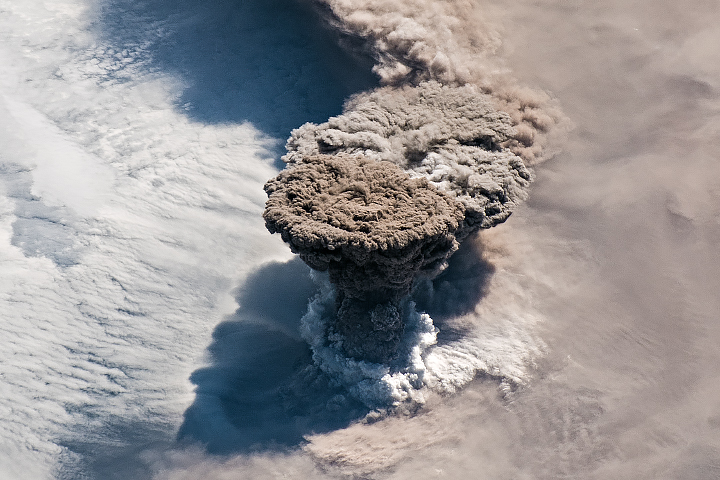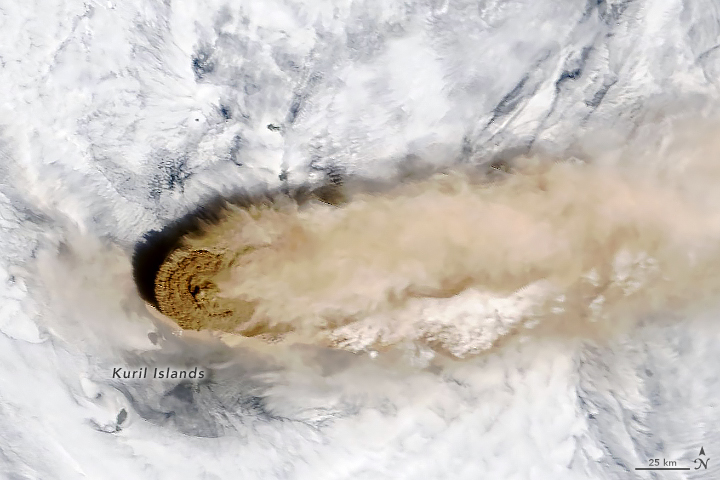Science
Related: About this forumVolcano Just Shot Out a Mushroom-Shaped Cloud So Big It Could Be Seen from Orbit
Last edited Thu Jun 27, 2019, 08:03 AM - Edit history (2)
By Mindy Weisberger
A towering mushroom-shaped cloud of ash and smoke recently rose from a volcano on an island in the Pacific Ocean, and an astronaut on board the International Space Station (ISS) captured a spectacular view of the eruption from high above.
The volcano Raikoke sits on the Kuril Islands, an archipelago of volcanic peaks that lies between Russia's Kamchatka Peninsula and Japan's Hokkaido Island. On June 22 at approximately 4 a.m. local time, Raikoke exploded for the first time since 1924, expelling a dense plume that could be seen from the ISS, NASA Earth Observatory reported.
The towering plume extended to an altitude of about 43,000 feet (13 kilometers); it rose from the volcano's crater and formed a spindly column that puffed out at the top. [The 11 Biggest Volcanic Eruptions in History]
In this highest zone of a volcanic plume, known as the umbrella region, the ash cloud's density equalizes with the density of the air around it, and the plume's rise slows and then stops, according to NASA. Circular gravity waves are visible in the plume's flattened top; they form as pulses of air from below push briefly above the plume's maximum height and then settle back down, an effect similar to the spreading ripples displaced by a stone dropped in water, according to the volcano-tracking website Volcano Discovery.
More:
https://www.livescience.com/65792-raikoke-volcano-from-orbit.html
Wounded Bear
(58,656 posts)krispos42
(49,445 posts)The other OP from 5 minutes prior has the same subject line, but actually links to a story about volcanoes.
![]()
Judi Lynn
(160,542 posts)Bayard
(22,073 posts)Versus a few electronvolts from our sun. That's amazing.
Eugene
(61,899 posts)
June 22, 2019
Source: NASA
Raikoke Erupts
Unlike some of its perpetually active neighbors on the Kamchatka Peninsula, Raikoke Volcano on the Kuril Islands rarely erupts. The small, oval-shaped island most recently exploded in 1924 and in 1778.
The dormant period ended around 4:00 a.m. local time on June 22, 2019, when a vast plume of ash and volcanic gases shot up from its 700-meter-wide crater. Several satellites—as well as astronauts on the International Space Station—observed as a thick plume rose and then streamed east as it was pulled into the circulation of a storm in the North Pacific.
On the morning of June 22, astronauts shot a photograph (above) of the volcanic plume rising in a narrow column and then spreading out in a part of the plume known as the umbrella region. That is the area where the density of the plume and the surrounding air equalize and the plume stops rising. The ring of clouds at the base of the column appears to be water vapor.
“What a spectacular image. It reminds me of the classic Sarychev Peak astronaut photograph of an eruption in the Kuriles from about ten years ago,” said Simon Carn, a volcanologist at Michigan Tech. “The ring of white puffy clouds at the base of the column might be a sign of ambient air being drawn into the column and the condensation of water vapor. Or it could be a rising plume from interaction between magma and seawater because Raikoke is a small island and flows likely entered the water.”

The Moderate Resolution Imaging Spectroradiometer (MODIS) on NASA’s Terra satellite acquired the second image on the morning of June 22. At the time, the most concentrated ash was on the western edge of the plume, above Raikoke. The third image, an oblique, composite view based on data from the Visible Infrared Imaging Radiometer Suite (VIIRS) on Suomi NPP, shows the plume a few hours later. After an initial surge of activity that included several distinct explosive pulses, activity subsided and strong winds spread the ash across the Pacific. By the next day, just a faint remnant of the ash remained visible to MODIS.
-snip-
Read more: https://www.earthobservatory.nasa.gov/images/145226/raikoke-erupts